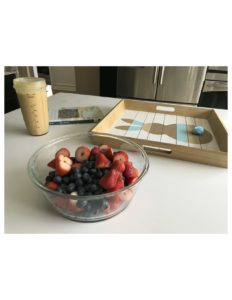Setting Your Athlete Up For Nutrition Success

SETTING YOUR ATHLETE UP FOR NUTRITION SUCCESS

Are you struggling to find a healthy balance between training, games, school and family time? I am guessing your answer is yes! Making sure your young athlete is eating the right foods is critical, not only to support their fueling and recovery from training, but to also support their energy requirements for physical growth and development. Planning ahead and educating yourself on how to provide them with the best possible nutrition should be your number one priority. Whether your child is eight years old or sixteen, you can have a positive influence on their nutrition success on and off the field. Let’s discuss how you can get started.
Tip #1- Educate yourself
Whether you are sitting down for a family meal or eating on the run, you want to fuel your athlete with the best possible nutrition. Knowing WHAT to your feed your child is the first step. Television commercials, billboards, magazines, and food stores throw the latest fads at us quicker than we can blink an eye. So how do you know which foods are the healthiest options when there are SO many products out there??? Stop, think, and do your research before choosing any new product. Or… focus on eating whole, real, colorful, fresh foods. Mother Nature is always right! Here are some other healthy guidelines to choosing the healthiest foods for your entire family:
- Choose REAL Shop the perimeter of the grocery store for fruits, vegetables, and dairy.
- Think about the rainbow when choosing fruits and vegetables- different colors have different health benefits.
- Buy seasonal produce at local farmers markets- they are less likely to use a lot of chemicals on their produce.
- Choose products with the least amount of ingredients on the label and make sure you can pronounce all of the ingredients.
- When choosing a whole grain product, read the ingredient list. Sometimes these products may only contain a fraction of a whole grain. For example, “crackers made with whole grain.” If the first ingredient on the list starts with “whole” such as whole wheat or whole oats, it is likely to be predominately whole grain. If the first ingredient is “enriched” it may contain as little as1% whole grain.
- Drink water at all meals and throughout the day. Have your child pick out a fun water bottle to increase their motivation. Don’t buy beverages with added sugar, caffeine, or artificial sweeteners.
- Buy sports drinks and use ONLY when your child is playing in a tournament and/or hot weather and requires electrolyte repletion. If they are only playing in one game, water will usually provide the hydration they need.
Tip #2- Balance
Consuming balanced meals and snacks throughout the day will ensure your athlete has enough energy in school and on the playing field. Your child should consume something every several hours and never skip meals. Consistent and balanced nutrition will keep your child focused and energized. Their nutritional needs on non-training days are very similar to ours. During training, games and/or tournaments, their nutritional needs may increase depending on the intensity and duration. On any given day, your athlete should include all of the food groups: carbohydrates, lean proteins, and fat.
- Carbohydrates For Energy
- Carbohydrates are our main source of energy and provide our bodies with the fuel needed for physical activity, brain function, and operation of all organs. The more complex the carbohydrate, the healthier it is for you. Encourage your child to choose whole grains such as brown rice, oatmeal, popcorn, and whole wheat bread.
- Protein For Growth
- Protein plays a role in repair, maintenance, and growth of body tissues. It also has a role in energy supply. Encourage your child to choose lean cuts of protein such as grilled chicken, baked fish, eggs, nuts, seeds, and beans.
- Fats for Heart Health
- Don’t be afraid of fat, it plays many important roles in our bodies. Fat provides our body with energy, contributes to the absorption of fat-soluble vitamins, and provides support for our internal organs. Good fats, or monounsaturated fats, include olive oil, avocados and nuts. Bad fats, otherwise known as saturated fats, include meat, butter and lard. Trans fats, or very bad fats, are in baked goods, fried foods and snack food.
EXAMPLES OF BALANCED MEALS:
Breakfast:
- 2 slices of whole grain bread topped with peanut butter and strawberry slices
- Oatmeal topped with fresh blueberries, almond, and honey
- Whole grain English muffin with low-fat cheese and a pear on the side
Lunch:
- Whole wheat tortilla with roasted turkey, low-fat cheese, lettuce and tomatoes; mixed fruit salad on side
- Greek yogurt topped with fresh fruit and low-fat granola
- 2 slices of whole wheat bread with peanut butter and bananas; whole wheat pretzels
Dinner:
- Whole wheat pasta topped with organic chicken sausage and broccoli cooked in fresh tomato sauce, garlic, and olive oil; garden salad on the side
- Burrito bowl: grilled chicken, red bell peppers, onion, avocado, corn, salsa and low fat cheese on top of brown rice
- Baked salmon with sweet potatoes and assorted roasted vegetables

*chicken sausage and broccoli I put on top of whole wheat pasta
Tip #3- Create A Positive Home Environment
Setting your child up for nutrition success starts in the home. As parents, you have an obligation to set a positive example for your children and get them involved in the healthy eating process. Studies show that children who are involved in meal planning and prep are more likely to consume nutritious foods. Here are some healthy tips:
- Start every morning with a healthy, balanced breakfast.
- Take your kids to the grocery store and have them pick out their favorite healthy foods and snacks.
- Clean out your pantry and stock it with healthy options.
- Make healthy foods visible. Put fruit in a bowl on the countertop; put yogurt and veggies in the front of the refrigerator; put healthy snacks in the front of the pantry. How could they resist those colorful berries below when they walk in the door from school?

- Use family meal times as a way to educate your family.
- Have your child pack their own school lunch or review the school menu together and discuss different options- always give them a choice.
- Have nutritious easy-to-grab snacks available. Examples include:
- Greek yogurt
- Low-fat chocolate milk
- KIND bars
- LARA bars
- Hard-boiled eggs
- Rice cakes with peanut butter
- Trail mix
- Fresh fruit
- Low-fat cheese sticks

*portion controlled, ready-to-grab snacks
- Create family meal theme nights for creativity and fun!
- Meatless Monday
- Taco Tuesday
- Wrap It Wednesday
- Leftovers Thursday
- Pizza and Film Friday
- Soup and Salad Saturday
- Slow Cooker Sunday
- Provide water at meal times and encourage your child to drink water throughout the day. Carrying a fun water bottle usually helps.
- Avoid beverages high in sugar and caffeine. Sports drinks are only necessary if your child is playing soccer for more than one hour and/or performing in a very hot climate. Water will usually be enough to hydrate them.
*If you or your child would like individualized nutrition education, please contact me at joanneogibson@gmail.com or go to my website: joannegibsondietitian.com
*I do accept some health insurance plans
Joanne Gibson, RDN, LDN, CLT, CPT
Nutrition and Wellness, LLC
